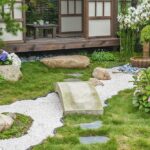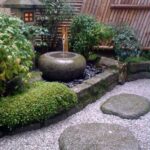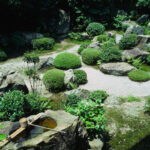Japanese garden design is deeply rooted in the principles of Zen Buddhism and the historical reverence for nature. These gardens are meant to be spaces of peace and tranquility, where individuals can connect with the natural world and find harmony within themselves. Traditional Japanese gardens typically feature elements such as water, rocks, plants, and paths, all carefully arranged to create a serene and balanced landscape.
One of the key aspects of Japanese garden design is the use of symbolism. Every element in a Japanese garden has a specific meaning, whether it’s a stone lantern representing enlightenment or a zigzag bridge symbolizing the journey to paradise. These symbolic elements are carefully chosen and placed to create a sense of harmony and balance within the garden.
Another important aspect of Japanese garden design is the concept of “borrowed scenery.” This refers to the practice of incorporating the surrounding landscape into the garden design, such as framing a distant mountain or incorporating a nearby stream. By seamlessly blending the natural surroundings with the garden itself, Japanese designers create a sense of unity and harmony between the two.
Water is a central element in Japanese garden design, symbolizing purity, vitality, and life. Water features such as ponds, streams, and waterfalls are often integrated into the design, adding movement and sound to the garden space. In addition to their aesthetic appeal, water features also serve practical purposes, such as providing a habitat for fish and other wildlife.
Plants are also carefully chosen and arranged in Japanese garden design to create a sense of harmony and balance. Japanese gardens often feature a variety of trees, shrubs, and flowers, each selected for its seasonal beauty and symbolic meaning. Moss and bamboo are commonly used in Japanese gardens for their lush greenery and textural contrast, adding depth and richness to the overall design.
Pathways play a critical role in Japanese garden design, guiding visitors through the space and creating a sense of journey and discovery. These paths are often made of natural materials such as gravel, stepping stones, or wooden planks, meandering through the garden and leading visitors to key focal points such as a tea house or a stone lantern. The winding paths encourage visitors to slow down, take in their surroundings, and appreciate the beauty and tranquility of the garden.















